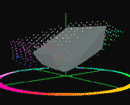FARBMANAGEMENT
L*A*B und ICC-Profile
Das vielleicht häufigste Workflow-Szenario beim digitalen Farbdruck ist das folgende: Ein Foto wird in einem RGB-Farbraum (von einem Scanner oder einer Digitalkamera) aufgenommen und anschließend auf einem Gerät mit einem CMYK-Farbraum (oder einer Version davon) gedruckt. Um das Szenario etwas zu verkomplizieren, sollten wir den RGB-Farbraum des Computermonitors berücksichtigen, auf dem das Bild angezeigt und verarbeitet werden soll. Dieser Raum ist nicht derselbe wie der ursprüngliche RGB-Raum, es sei denn, wir ergreifen Maßnahmen, damit sie übereinstimmen.

Typisches Szenario für die Farbraumkonvertierung
Obwohl unendlich viele Variationen dieses Szenarios möglich sind, beschreibt es die grundlegende Herausforderung für einen sehr hohen Prozentsatz der kommerziellen Arbeitsabläufe. Einfach ausgedrückt, besteht das Problem darin, diese geräteabhängigen Farbspezifikationen aus dem Originalfarbraum in den Ausgabefarbraum zu übersetzen und dafür zu sorgen, dass der endgültige Druck dem Original so nahe wie möglich kommt. Was wir brauchen, ist eine Möglichkeit, diese subjektiven, geräteabhängigen Farbräume miteinander kommunizieren zu lassen.
L*a*b*-Der unabhängige Farbraum
Die Antwort ist der L*a*b*-Farbraum, ein geräteunabhängiger Farbraum, der einen "universellen" Referenzstandard bietet. Dieses wissenschaftliche Farbmodell wurde 1931 von einer Organisation namens Commission Internationale de l'Eclarage, besser bekannt als CIE, entwickelt.
Der CIE L*a*b*-Raum ist zum De-facto-Standard geworden, mit dem die verschiedenen Geräte und Prozesse, die in der grafischen Industrie verwendet werden, in Bezug auf Farbinformationen miteinander kommunizieren. Betrachten Sie den L*a*b*-Raum als einen mehrsprachigen Übersetzer. Obwohl ein Gerät nur RGB und ein anderes nur CMYK spricht, versteht der L*a*b*-Übersetzer beide und erleichtert die Kommunikation.
Wie L*a*b* funktioniert
L*a*b* unterscheidet sich von RGB und CMYK unter anderem dadurch, dass es keinen subjektiven Satz von Primärfarben verwendet. Das bedeutet, dass er nicht an ein bestimmtes Tintenset (wie bei einem Tintenstrahldrucker) oder an eine bestimmte Art von Leuchtstoff (wie die, die die Farben auf Ihrem Bildschirm erzeugen) gebunden ist.
Der L*a*b*-Raum beschreibt Farben durch ihre Position entlang dreier Achsen im 3D-Farbraum. Die L-Achse stellt die Helligkeit des Bildes dar - ein Maß für den Weiß-zu-Schwarz-Anteil einer beliebigen Farbe. Die a-Achse verläuft von Rot nach Grün und die b-Achse von Gelb nach Blau.

| Die Position im L*a*b*-Raum ist folgendermaßen definiert: → L-Wert von 0 (alles schwarz) bis 100 (alles weiß) → Position auf der a-Achse, ein Bereich von -128 (grün) bis 127 (rot) → Position auf der b-Achse, ein Bereich von -128 (blau) bis 127 (gelb) |
Jede Farbe kann mathematisch beschrieben werden, indem man ihre Position in diesem physischen 3D-Raum definiert. Die L*a*b*-Werte einer Farbe werden durch Messung der Farbe mit einem Kolorimeter oder Spektralphotometer ermittelt. Die Unterschiede zwischen den Farben können anhand des Abstands zwischen ihnen bestimmt werden. Dieser Abstand wird manchmal in Form von Delta E definiert - der minimalen Farbabweichung zwischen zwei Farbtönen, die das Auge wahrnehmen kann.
ICC-Farbprofile
Ein Farbprofil ist eine Beschreibung der numerischen Beziehungen zwischen zwei Farbräumen. Die Farbprofile, die wir besprechen werden, sind ICC-Profile. Ein ICC-Profil ist eine Beschreibung eines Farbraums in Form seiner L*a*b*-Werte. Die Bezeichnung ICC steht für International Color Consortium, eine Gruppe von acht bedeutenden Unternehmen aus der Farbbranche.
| GRÜNDUNGSMITGLIEDER | AUSGEWÄHLTE ORDENTLICHE MITGLIEDER |
| Adobe Systeme Agfa Gavaert Apple Computer Eastman Kodak Microsoft Corp. Silizium-Grafik Sun Microsystems |
Farbengewandt CreoScitex Dupont Farbproofing Fuji Fotofilm Gretag Macbeth Heidelberger Druckmaschinen Pantone, Inc. |
In einer der erfolgreichsten unternehmensübergreifenden Kooperationen hat diese Organisation das ICC-Profilkonzept als das einzige Konzept für wissenschaftliches Farbmanagement in der Stadt etabliert. Obwohl verschiedene Unternehmen eigene Implementierungen von ICC-Profilen haben, sind die Standards für ICC-Farbprofile öffentliches Eigentum. Dies kommt einem Standard in einer Wissenschaft, die von Natur aus subjektiv ist, wie die Farbe, am nächsten.
Ein Farbprofil kann mehrere Arten von Farbräumen beschreiben. Das vielleicht bekannteste ist ein Ausgabeprofil, das alle Faktoren enthalten sollte, die den Druck beeinflussen. Beim Tintenstrahldruck beispielsweise umfasst ein komplettes Ausgabeprofil den Tintensatz, die bedruckbaren Medien, den Drucker, alle seine Einstellungen und Linearisierungskurven, Rasterschablonen und so weiter.
Ein Eingabeprofil kann auch die Eingabebedingungen für RGB, CMYK oder einen anderen Farbraum beschreiben. Typische Eingabeprofile sind Scannerprofile, Monitor- oder Arbeitsbereichsprofile oder CMYK-Profile für eingehende Schmuckfarben. Für die Proofing-Simulation ist es auch möglich, ein Ausgabeprofil als Eingabeprofil zu verwenden.
Wie Profile funktionieren
In seiner einfachsten Form besteht ein Profil aus einer Reihe von Farbtabellen. Die folgende Tabelle zeigt zum Beispiel Farbbeispiele von einem hypothetischen RGB-Scanner und die L*a*b*-Entsprechungen.
| Farbe | RGB | CIE L*A*B |
| A Rot | 203,0,23 | 50, 71, 54 |
| A Dunkelblau | 0,46,160 | 32, 34, -71 |
| A Gelb | 255,243,0 | 95, -17, 99 |
| A Grün | 0, 139, 74 | 56, -81, 32 |
Die nächste Tabelle zeigt die gleichen Farben, die in CMYK gedruckt und mit einem Kolorimeter gemessen wurden.
| Farbe | Cmyk | CIE L*A*B |
| A Rot | 203,0,23 | 50, 71, 54 |
| A Dunkelblau | 0,46,160 | 32, 34, -71 |
| A Gelb | 255,243,0 | 95, -17, 99 |
| A Grün | 0, 139, 74 | 56, -81, 32 |
Die Kombination dieser Tabellen zu einem Linkprofil ergibt die folgende Tabelle. Auf diese Weise stellt Wasatch SoftRIP die Farbgenauigkeit für praktisch alle Standard-Druckszenarien sicher, mit denen unsere Benutzer konfrontiert werden können.
| RGB | CIE L*A*B | Cmyk |
| 203, 0 23 | 50, 71, 54 | 0, 100, 91, 0 |
| 0, 46, 160 | 32, 34, -71 | 100, 69, 0, 0 |
| 255, 243, 0 | 95, -17, 99 | 6, 0, 91, 0 |
| 0, 139, 74 | 56, -81, 32 | 100, 0, 79, 0 |
In der Praxis setzt sich ein ICC-Profil aus zwei Hauptkomponenten zusammen: dem Header und dem Tag. Die Kopfzeile identifiziert einfach den Typ des Profils. Das Tag definiert numerisch die Transformation zwischen dem Zielfarbraum und seinen L*a*b*-Werten. Zum Profil gehört auch der Rendering Intent, d. h. die Art und Weise, wie die Farbanpassung auf das Bild angewendet wird. Unser Artikel über Rendering Intents geht näher auf dieses Thema ein.
